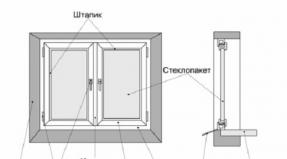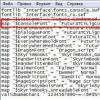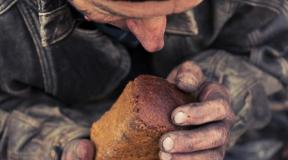Exercise for a bowel movement in the morning. Exercise for the intestines with constipation: how to say goodbye to a delicate problem. A versatile exercise for constipation
Constipation in most cases occurs as a result of malnutrition and a decrease in the activity of intestinal motility. The movement of the food lump through the intestines is difficult not only with an incorrectly selected diet, but also if a person does not move much.
Exercise for the intestines, performed regularly, will allow you to achieve a reduction in the effect of physical inactivity on the intestines. Under their influence, the following changes occur:
- improves blood circulation in the pelvic organs;
- the muscles of the press are strengthened;
- metabolic processes are improved.
Exercise will help you eliminate constipation, thereby avoiding laxatives. Specially selected physical exercises must be combined with an increase in general physical activity throughout the day.
With a tendency to constipation, the following are useful:
- long distance walking;
- jogging;
- swimming;
- cycling and skiing;
- tennis.
When choosing the type of physical activity, consider age, place of residence, habits, general well-being, and traditions adopted in the family.
Remember: Exercise will not help you if constipation is a manifestation of certain conditions. With chronic stool delays, especially if they have arisen while observing measures to prevent poor bowel function, it is necessary to undergo an examination.
Exercise rules
Physiotherapy will relieve you of constipation and will be of great benefit if you do it regularly. You can do the selected set of exercises several times a day, always in the morning before breakfast, this will help to activate the digestion process. Follow a few rules when conducting.
- Do the exercises either on an empty stomach or at least an hour and a half after eating.
- Do not choose those physical exercises that are performed with great effort. Charging is recommended to the best of your usual physical capabilities.
- Before starting the gymnastics complex, it is advisable to drink a glass of water, this will further enhance intestinal peristalsis.
- Be sure to choose a diet that will promote better absorption of food and faster passage of the food lump through the digestive tract.
For constipation, ordinary exercises, breathing exercises, self-massage of the abdomen, aerobic exercises are useful. They can be performed separately from each other, and in combination.
4 easy exercises
A recommended set of simple exercises to help relieve constipation. Perform all of these activities lying on a horizontal surface, so they can be done in the morning after sleep and repeated periodically throughout the day.
Exercise 1
- Lying on your back, keep your legs together, then also lift your legs up together.
- The distance from the bed or floor must be at least 25 centimeters.
- Hold your legs in this position for up to 15 seconds.
- Repeat the exercise 3-6 times.
Exercise 2
- Lying on your stomach, spread your legs a little and lift them one by one, holding them in the air for up to 10 seconds.
- Repeat swings up to 7 times.
Exercise # 3
- Lying on your back, lift your legs up, then extend your arms up.
- As you exhale, tear your back from the horizontal surface, sit down, while lowering your legs.
- Place your hands parallel to the lower limbs.
Exercise 4 - Bicycle
Exercise "bicycle" helps with constipation: Alternately, pull your bent legs to your stomach.

10 challenging and effective exercises
There are more complex exercises that optimally enhance intestinal motility, a few of them are listed below.
Exercise 1
- While standing, take a deep breath while pushing your stomach forward strongly.
- As you exhale, pull in your stomach.
- After a pause of 5-7 seconds, repeat the described exercise.
- After three repetitions, push, as in the process of bowel movement, then relax, breathe calmly.
- Repeat the lesson 5-7 times.
Exercise 2
- From a standing position, raise your bent knees as high as possible.
- Pull the bent limb as close to the stomach as possible.
- Do the exercise up to 10 times for each side.
Exercise # 3
- Bent leg while standing, pull it to the stomach and fix it with your hands.
- Place one hand on the ankle, the other support the leg by the knee.
- Stand in this position as long as possible.
Exercise 4
- Lie on a horizontal surface, pull your bent legs to the abdominal wall and at the same time push your knees apart from each other.
- Then, little by little, bring your legs together again and lower them.
- Repeat the exercise 10 to 15 times.
Exercise 5
- Sitting down on your stomach, bend your legs and try to reach your back with your feet.
- Do the lesson up to 7 times.
Exercise # 6
From a prone position, lean on your arms as far as possible and sweep down as far as possible.
Exercise 7
- Lie on your side, support your head with your palm, lift your leg so that it is at right angles to your torso.
- Do 10 to 15 swings with one lower limb, then repeat the swings with the other.
Exercise 8
- Sit on the floor, stretch your legs forward, tilt your torso forward, with your palms, reach the tips of your toes.
- Do this exercise slowly and without making sudden movements, repeating it up to 7 times.
Exercise 9
- Squats for constipation are effective for restoring bowel function at any age.
- Young people can do 10-20 deep squats in one set.
- Seniors should squat slowly so that the pelvic region drops to knee level.
Exercise # 10
- Strengthening peristalsis is well reflected by body tilts to the sides, turns around the axis, rotational movements of the torso to the left and to the right.
- Do these exercises 10-15 times in one session.
With constipation, physiotherapy exercises can always be supplemented by jogging on the spot, walking on all fours, yoga.
Work digestive system and the general tone of the body will significantly improve after a week of regular exercise.
Gymnastics for hemorrhoids
Gymnastics for hemorrhoids, one of the manifestations of which is constipation, is performed according to the same principles.
Just keep in mind that in the acute stage of the disease, some exercises can increase discomfort, so it is necessary to perform the lightest exercise complexes before the state of hemorrhoids normalizes.
Conducted gymnastics for hemorrhoids can be aimed at strengthening the muscles of the perineum and rectum. It is useful to perform the Kegel complex, classes according to the Norbekov method.
For constipation, choose an exercise that will not cause severe discomfort. If you have chronic diseases of cardio-vascular system, musculoskeletal system and pelvic organs, it is advisable to consult a doctor who will tell you which methods of exercise therapy will be beneficial and which can harm.
The simplest bowel exercises that help with constipation can be done immediately after waking up, without getting out of bed. Its implementation will ensure the revitalization of the digestive tract. Advice from Elena Malysheva.
Breathing exercises
Sometimes, when treating constipation in an adult, breathing exercises become an alternative to conventional gymnastics.
In the last stages of pregnancy, bedridden patients, with fractures of the limbs and in other situations, it is impossible to perform most of the usual exercises.
Having mastered several methods of controlling your own breathing, you can normalize bowel function without the help of laxatives.
Diaphragmatic breathing is easier to master from a lying position on a horizontal surface. The easiest ways to relieve constipation are through breathing.
- Place your palm in the middle of the abdomen and exhale so that the abdominal wall extends as far as possible to the spine.
- Then inhale so that the incoming air is taken in by the stomach. At correct execution the stomach will rise as high as possible. Use your palm to help control the movement of the abdominal wall.
- As soon as the palm goes down, take a deep breath, while lifting up, exhale.
- Breathing with the diaphragm, first master lying down, then you need to learn how to do it while sitting and standing.
Experts advise doing breathing exercises both during physical exercise and separately. The combination of diaphragmatic breathing and bowel exercises will help you to eliminate the most persistent constipation.
Self-massage
The term self-massage refers to the performance of exercises that normalize the contractile function of the large intestine.
All elements of self-massage are performed lying down, it is useful to do them in the morning after waking up.
Massage launches the digestive system, relieves the discomfort that often occurs with constipation.
- Begin self-massage with light stroking movements. Stroke your abdomen clockwise with your palms for 3-5 minutes.
- In the next step, gently massage the most painful areas.
- The most attention should be paid to the left area, starting in the middle of the abdomen and going down. It is in this place that the intestine with the greatest accumulation is located feces.
If you have persistent constipation, then after a self-massage session it is better to drink a glass of salted water, it activates the motor function.
This method of eliminating constipation leads to a positive result within half an hour.
Increasing physical activity for constipation is an important step in improving the functioning of the large intestine.
Sometimes, in order to achieve a normal, regular bowel movement, it is enough to eliminate hypodynamia and follow the principles of proper nutrition.
Constipation is a problem that periodically worries almost all of us. In most cases, we do not pay special attention to this delicate issue, although the presence of constipation can significantly worsen the quality of our life and harm our body. In what situations can we talk about the presence of constipation and what methods of treatment and prevention are most effective for this problem ?!
First of all, it should be noted that constipation is not a disease, but a symptom that manifests itself in the form of a prolonged absence of stool (at least three times a week) or incomplete bowel movement. The nature of constipation is varied. Most often, their occurrence is due to functional impairment bowel function, less often organic disorders or abnormalities in the development of the gastrointestinal tract. Within the framework of this article, we will restrict ourselves to a consideration of the so-called functional constipation caused by malfunctioning of the intestines.
Rice. 1. Organs of the abdominal cavity *
Most frequent reasons functional constipation are stress, unhealthy diet, intake of some medicines, low physical activity.
By the nature of the occurrence, atonic and spastic functional constipation is distinguished. In the first case, due to the long absence of stool, the feces become denser, acquire a large volume, which causes difficulty in emptying. During bowel movements, the patient experiences difficulty and pain, and the feces come out unevenly: the first portion is larger and denser than the last. In the second case, the patient is worried about flatulence, acute pain in the lower abdomen. His appetite decreases, irritability appears. The feces appear as small, hard lumps, often with mucus.
Constipation treatment is complex and includes the following measures:
- drug treatment;
- physiotherapy exercises (exercise therapy) and physical activity;
- diet;
- massage;
- prevention of stress;
- elimination of bad habits;
- physiotherapy.
Thus, therapeutic exercises and physical activity are one of the main factors for the treatment and prevention of constipation. Physical therapy helps to normalize intestinal motility, restore the mechanisms of formation and excretion of feces. It is also an important factor in the restoration of the psychoemotional and physical state of the patient.

Rice. 2. The principles of exercise therapy for constipation
Physiotherapy
For spastic constipation
Exercise therapy in this case is aimed at relieving spasms of the intestinal muscles. The set of exercises must comply with the following principles:
The optimal time for training is in the morning. If it is convenient to charge at other times, make sure that at least 2 hours have elapsed after eating. You can drink a glass of water before exercising. A set of exercises should be performed daily. Before classes, you should consult with your doctor or exercise therapy specialist.

With atonic constipation
The set of exercises must comply with the following principles:
- load - above average, with a lot of repetitions;
- the pace of exercise is medium and high;
- be sure to include in the complex a variety of exercises for the press, deep diaphragmatic breathing;
- useful running, squatting, jumping, turning, bending, exercises with weights and resistance.
The time and frequency of the exercises are the same as for spastic constipation. Before classes, you should consult with your doctor or exercise therapy specialist.
Below is an approximate set of exercises for constipation.

Abdominal massage for adults (+ video)
Sophisticated can refer to the massage technique described in the book by A.A. Biryukov. "Massotherapy" . For the rest, we offer the simplest massage option. The optimal duration of a massage session is 10 minutes, a course of 15-20 procedures, 2-3 courses a year. The procedure is best done every other day, 2-3 hours after eating.
The massage begins with stroking the entire back, rubbing, kneading (longitudinal, transverse), it is recommended to use vibration techniques (patting, light chopping). Then the patient rolls over from the abdomen to the back. Lying on your back, you can already perform self-massage.
Massaging the abdomen, perform circular stroking with the palm (clockwise), starting from the pubic bone and costal arch to the navel, with a gradual narrowing of the circle (2-4 times). The same is done, moving from the navel to the costal arch, with a gradual expansion of the circles. In these directions, you can vibrate with your fingers, as well as light pressure with your fingers over the entire surface of the abdomen.
After the massage, you can drink a glass of slightly salted water (a quarter teaspoon of salt).
You can find another massage option with pictures and videos in our other.
Other physical activity
Running and swimming can help treat and prevent constipation. These types of physical activity normalize intestinal motility and peristalsis, carry out a natural massage of organs gastrointestinal tract, improve the emotional state of a person. You need to engage in cyclic types of exercises no earlier than 2 hours after eating. After physical exertion, it is advisable not to eat for at least an hour.
Bibliography
- Biryukov A.A. Massage therapy: Textbook for students. higher. study. institutions. - M .: Publishing Center "Academy", 2004. - 368 p.
- Vasichkin V.I. Great guide to massage. - SPb .: Nevskaya kniga, Moscow: Eksmo Publishing House, 2004 .-- 448 p.
- V. I. Dubrovsky Therapeutic physical education(kinesiotherapy): Textbook. for stud. higher. study, institutions. - 2nd ed., Erased. - M .: Humanit. ed. center VLADOS, 2001 .-- 608 p .: ill.
- Handbook of children's physiotherapy exercises / Ed. M.I. Fonareva. - L .: Medicine, 1983 .-- 360 p.
Difficulty emptying the bowel from feces is a serious medical and social problem. Some doctors consider this condition to be an independent disease, others - a symptom of other pathologies. However, the difference in views does not affect the statistics in any way.
Elderly people have constipation 5 times more often than young people. Their prevention and treatment is carried out in a complex manner, since the use of one of the methods can give a quick, but only one-time effect.
An important part of such events are different shapes Exercise therapy, including exercises for constipation in the elderly.
Unfortunately, not every local doctor pays due attention to his elderly patients, especially when it comes to exercise therapy. In such cases, you can hear: "Move more, well, or as you can."
The information, photos and videos in this article will help retirees or their relatives choose exercises and draw up an individual plan for daily activities that will help get rid of the problem, and then keep the situation under control. Further in the text, synonyms from medical terminology will be used for the word Constipation - constipation, constipation.
Comprehensive treatment for constipation
Of course, first of all, the disease should be treated, which is the reason for the difficulty of fecal eruption. However, what to do for those who have this condition not due to specific diseases, but manifests itself due to natural aging of the body, forced bed rest, or, for example, caused by certain medications, the use of which is necessary for the treatment of diseases not related to the intestines, stomach, liver or pancreas?

Today, with constipation in the elderly - senile constipation, therapists or gastroenterologists offer the following methods:
- individual selection of dietary and varied (!) diet, as well as the amount of the daily drinking balance;
- transfer of the diet from 2 times a day to fractional, at least 5 times a day;
- limiting the consumption of table salt;
- activation of the motor regime;
- phytotherapy;
- reception of osmotic, "engine" and combination drugs, setting of salt microclysters;
- if necessary, the appointment of painkillers, sedatives and hypnotics, other types drugs- antispasmodics, probiotics, enzymes, sorbents, defoamers.
Attention! All laxative drugs are addictive, so their intake must be alternated without fail, and between changing the type of drug, pause, during which, if necessary, put enemas.
Forms of exercise therapy for constipation
Maintaining an active motor regime in old age is especially important. Physical exercise, different kind and character, stimulate intestinal motility, at least maintain the tone of all muscles, including the abdominal wall and pelvis, increase the sensitivity of the anal sphincter and, importantly, have a beneficial effect on the neuropsychic state.
Not all elderly people have the opportunity to go to the pool, ride a bicycle or go skiing, and some of them are not able to do such physical activity due to their old age.
However, all retirees can do:
- exercise for or for constipation;
- special massages for constipation;
- morning exercises and evening hitch;
- yoga or gymnastic exercises for constipation for retirees;
Most older people can do walking and dosed Nordic walking. Such species physical activity- excellent prevention of constipation in the elderly. They will also help keep the inevitable osteochondrosis, osteoporosis, varicose veins under control. lower limbs and other pathologies of the cardiovascular system.
Types and symptoms of constipation
In order not to harm the body and not aggravate the pathological condition, before doing physical exercises for constipation for the elderly, it is necessary to find out what kind of it was formed. The characteristics of therapeutic movements and massage will directly depend on this.

There are 2 types of constipation - atonic and spastic. The former are due to the weakening of the muscular layer of the intestinal walls.
They are more common than spastic constipation caused by prolonged contraction of the circular muscle fibers. In addition to the well-known symptoms, each type of constipation has its own specific manifestations.
For atonic constipation, the following symptoms are characteristic:
- the appearance of an unpleasant taste in the mouth and plaque on the tongue;
- the belly is bursting, and pain in it they are spilled, aching in nature;
- a small amount of liquid feces, bypassing the fecal plug and flowing down the intestinal walls, stain the laundry;
- on the surface of the feces, there are bloody traces;
- at first, a dense, sausage-like, well-formed feces comes out, and after it a semi-shaped one.
Spasmodic constipation can be recognized by the following symptoms:
- pain is localized in the lower part or in the left half of the abdomen;
- pain syndrome, in the majority, manifests itself in the form of acute colic or burning;
- feces come out in small "sheep pellets" covered with ribbon-like mucus.
Attention! Appointment antispasmodics with spastic constipation is only in the competence of the attending physician. Do not self-medicate. Even in healthy young adults, certain combinations of antispasmodics, prokinetics, and laxatives can cause a sharp drop. blood pressure, severe flatulence and diarrhea, dehydration.
A versatile exercise for constipation
For any type of difficulty, spastic or atonic, or in the absence of defecation at all, the main and main form of exercise therapy for constipation, which is shown to absolutely everyone, without exception, is breathing exercises, namely, static diaphragmatic breathing performed at rest, i.e. no physical movement of the trunk and / or limbs.

The dosage of diaphragmatic breathing cycles is individual. Some older patients can only make 2-3 accentuated inhalation-exhalation with the abdomen, while others feel better to do more repetitions. However, in any case, “belly breathing” is necessary not only daily, but also as often as possible, preferably every half hour, for 1-3 minutes.
The technique of diaphragmatic or abdominal breathing for constipation is extremely simple:
- Starting position - any: lying, lying with bent legs, sitting, standing, standing in a semi-tilt, with palms resting in the middle of the thighs, legs slightly bent at the knees.
- While inhaling, the chest must be kept motionless, inflating (protruding) the abdomen.
- On exhalation, the abdominal muscles must be strained, pulling the stomach into yourself as much as possible.
Advice. For the first couple of days of diaphragmatic breathing practice, keep one palm on the heart area and the other on the belly button. This will help control immobility. chest and movement of the anterior abdominal wall. Further, to strengthen therapeutic effects in the supine position, you can put a small weight on your stomach, for example, a bag of cereals (0.3-1 kg).
Features of therapeutic exercises against constipation

Gymnastics for constipation for the elderly and elderly people is compiled according to the following methodological instructions:
- The number and duration of the therapeutic gymnastics complex depends on the motor regime:
- bed - 5-10 minutes, 4-5 times a day;
- half-bed - 15-20 minutes, 3 times a day;
- free - 30 minutes, 1-2 times a day.
- The lesson is held shortly before the main meal. Do not exercise immediately after eating. You have to wait 30-45 minutes.
- It is forbidden to exercise at high body temperature, exacerbation chronic pathologies, during the acute period infectious diseases, in the presence of any acute pain syndrome, high pressure... The exception is breathing exercises. Static diaphragmatic breathing should be done anyway. Little by little, but often.
- With spastic constipation, gymnastics includes techniques for relaxing self-massage of the abdomen and lower back with alternating exercises:
- general developmental character;
- respiratory;
- diaphragmatic breathing performed in motion;
- to relax the abdominal muscles (the main share in the lesson);
- to maintain the tone of the muscles of the abdomen and back, but without static stress, straining and overstraining.
- The basis of therapeutic exercises for atonic senile constipation is static and dynamic exercises for the muscles of the abdomen, pelvic floor and back. They are "diluted" with deep diaphragmatic breathing cycles, general developmental exercises and deep abdominal self-massage techniques. In this case, it is necessary to often change the starting positions from which these exercises are performed.
- The number of repetitions of each exercise to tone the abdominal muscles - according to sensations, to feeling slight fatigue and breathing exercises should not cause discomfort or dizziness. All other types of exercises should be repeated on average 4-6 times, no more. Let us give, for example, some types of therapeutic movements for constipation that older people can perform.
Special exercises for spastic bowel problems
| Name and photo | Brief instruction |
 |
Since it may be difficult for older people to “pedal” with both legs, you can perform this exercise in a lighter version - work first with one leg and then with the other. Rotational movements are done with a different angle of elevation of the hip and not only forward, but also backward. |
 |
You must move during the exercise smoothly, without jerking. The amplitude should be small. With spastic constipation, it is impossible to linger and strain at the extreme point of deflection. This warning applies to other exercises of a similar type, including those performed from a supine position. |
 |
Example 1.
|
 |
Elderly people can do this exercise without any problems, since the body does not need to be lifted. It is only necessary to slightly raise the shoulders and stretch forward behind the palms until a slight tension of the abdominal muscles appears. After completing other exercises, repeat it again, but now stretch to the right and then to the left. |
 |
In contrast to the above-described diaphragmatic breathing technique, when the muscles on exhalation are tense, in order to achieve relaxation of the muscles of the peritoneum, after an intense inhalation and an increased extension of the abdomen forward, first relax puffy belly and breathe out calmly but continuously. Muscles will retract by themselves. Start mastering this technique while lying on your back, bending your knees, feet resting on the floor. |
 |
Rotation of the pelvis will help to relax the muscles of the pelvic floor and lower abdomen, but subject to the following rules:
|
In the overwhelming majority of cases, spastic constipation develops due to diseases of the gastrointestinal tract, therefore exercises for constipation are included in the exercise therapy complexes, which the doctor makes for the treatment of the underlying disease.
Light exercise for atonic constipation in the elderly
For the treatment and prevention of problems with fecal eruption of an atonic nature, any exercises that pump the muscles of the press and back are suitable. Another thing is that not all of them can be performed in old age.
Here are some examples of exercises that are suitable for retirees of different ages. By the way, all of the above exercises are not contraindicated with this type of constipation.
| Image and title | Explanation |
 |
From the position, as in the photo, note that the palms are placed under the buttocks, pull the knees closer to the chest, and then return to the starting position. Then, one at a time, pull your knee toward one shoulder and the other. This dynamic exercise is not suitable for obese people. They should pull their knees as close to them as possible and fix this position for a few seconds. You cannot help with your hands. |
 |
Get into a lying position. The line of the spine (neck and back) should be straight. Stand still until tired, not forgetting about rhythmic breathing. By the way, in this position, you can try to perform diaphragmatic breathing. If you have strength, then at the end of the exercise, do one push-up. |
 |
Lying on your back, bend your legs, as in the photo, pulling your socks over yourself. Place your palms behind your head and lift your shoulders off the floor. Freeze in this position until tension appears in the abdomen, and tolerate it for 1-2 seconds. Straighten up, rest, and then do this exercise dynamically. Keeping the legs in the indicated position, rhythmically |
 |
With your back rest on your forearms, keep your neck straight. It is not necessary to arch the torso. The line of the spine should be straight. Breathe shallowly but rhythmically. If you feel tired in any part of your body, stop doing the exercise. |
 |
Take the starting position as in the photo.
Repeat the exercise smoothly, until fatigue, independently adjusting the distance to which the legs are spread, as well as the angles of bend in the hip and knee joints. |
 |
You can move on the buttocks not only forward and backward, but also to the sides. By the way, these movements will help maintain the tone of the muscles serving the hip joints, and improve their blood supply. To avoid injury, older people should perform all movements smoothly and slowly. Moving the buttocks in jerks can damage the lower back. |
 |
Lie on the floor, bend your legs, placing your feet on the floor, as close to your buttocks as possible. Make the pelvis lifts up. Exhale as you rise, and inhale as you descend. After you are tired and rested, do this static exercise. Keep in this position for as long as you can. After a few sessions, the exercise can be made more difficult by diaphragmatic breathing. |
Like any other exercise therapy exercise, finish gymnastics from constipation with final exercises. Before lying down for 3 minutes in the Shavasana yoga pose, stand on your right and then on your left leg in the Golden Rooster pose as long as you can. Balancing on one leg has a beneficial effect on the digestive tract and rejuvenates the entire body.

Self-massage of the abdomen
Of course, it is better that the massage of the abdomen for constipation in an elderly person is performed by a specialist. However, many find it difficult to go to the massage parlor. Of course, there is a service to call a masseur at home, but it is not affordable for everyone.
Nevertheless, there is a way out. There are simple massage techniques that you can perform yourself:
Stroking and squeezing along the colon

This self-massage of the abdomen is performed according to the following rules:
- Massage lines and hand positioning:
- first, with the edge of the right palm, in one motion, a section of the ascending intestine is stroked - from bottom to top, from appendicitis to the liver (1);
- then, with the left palm and the base of the right palm, wiring is performed along the transverse colon - from the liver, below the stomach to the pancreas (2);
- the last segment - the descending colon, is massaged in one long movement with the bases of the palms, in the direction from the pancreas to the left groin, from top to bottom;
- pay attention, the area of the sigmoid and rectum is not massaged (!).
- The number of repetitions of massage "semicircles": 10-12 times in a row, from 6 to 8 times a day, with equal intervals between massages.
- Characteristics of massage techniques. The first and second time, just stroke your belly. Then gradually increase the stroking force. In the middle of the cycle, make several "semicircles" with significant effort, corresponding to the Squeeze technique. Then begin to gradually reduce the pressure until stroking.
- These massage movements also need to be performed between morning exercises and exercise therapy exercises. In this case, do light strokes, 2-3 times, after several exercises for the abdominal muscles.
Attention! Self-massage of the large intestine, as well as exercise therapy, should never be done immediately after a meal, and about 15 minutes should elapse between the end of the massage and the meal.
Point Column Massage

Once, every 2-3 days, after stroking and squeezing out the large intestine, described above, you can add its acupressure.
At each point, the order of which is indicated at the top in the photo, for 1-2 minutes, in a prone position, you can keep your legs bent, do the following massage manipulations:
- put your fingertips on the massage point, take a breath;
- as you exhale, press your fingers 2-3 cm down, and rotate clockwise, moving the skin, but without lifting your fingers from the abdomen;
- as you exhale, stop the massage movements, but your fingers should remain on the skin.
On a note. Colon massage can be expected not only positive impact to work the large intestine. Changes in intra-abdominal pressure are a powerful factor in enhancing extracardiac blood circulation, which improves the functioning of the cardiovascular system in high blood pressure(hypertension).
R-Dzyan point reflex massage

This reflex massage method will not work for all seniors. However, for those who correctly understood and correctly apply this technique, it brings tangible results. Anyway, it's worth a try. The price of the issue is zero, no physical effort is needed, there are no contraindications, and there will be no negative consequences.
Massage rules:
- The R-Dzian point is located in the first third of the inner side of the first phalanx of the index fingers. If you run along the index finger with the pad of the finger of the other hand, from the base of the finger to its end, then the first small depression in the phalanx will be the desired place for pressing.
- The massage is performed while sitting, the massaged brush lies on the table.
- You can press on the point with the pad of any finger of the other hand.
- For 3-5 minutes, press on the point located on the left hand as follows:
- about 5 seconds with medium effort (until pain appears);
- at 6 seconds, press with all your might and abruptly remove the pressing finger from the point;
- pause for 1-2 seconds, and continue pressing further.
- Repeat the same manipulations on the right hand.
Important! For a tonic effect, as well as to avoid addiction and the intestines are not "lazy" completely, do this reflex massage once every 2-3 days, no more and no more often.
And in conclusion, watch the video, exercises from which may well be included in the gymnastics complex for constipation in the elderly.
Today almost every third person has a delicate problem. This is due to poor nutrition, stressful situations, inactivity and other reasons. Exercising for constipation is a good home remedy for constipation. You can not only forget about such a problem, but also bring your body back to normal and shape, improve blood circulation, skin color.
Benefits of exercise for constipation
The cause of constipation is very often unhealthy diet and decreased activity of intestinal motility. Also, an important cause of constipation is inactivity. Therefore, constipation is common in older people.
There is a complex special exercises from constipation, which can reduce the effect of physical inactivity on the intestines. This can happen if you do them regularly.
When doing them, constipation may develop some changes:
- Improving metabolic processes;
- Strengthening the abdominal muscles;
- Improving blood circulation in the pelvic organs.
If you regularly do gymnastics for constipation, then you can sometimes not use laxatives. In addition to gymnastics for constipation, you need to increase general physical activity throughout the day.
If you have frequent problems with constipation, you need constant long-distance walking, swimming, skiing, jogging, cycling, and tennis. In such cases, the place of residence, age, habits, traditions in the family, general well-being are taken into account.
One of the main causes of constipation and diarrhea is the use of various medications... To improve bowel function after taking medications, you need every day drink a simple remedy ...
Types of gymnastic exercises
There are several types of gymnastic exercises for constipation:
- Breathing exercises;
- Therapeutic;
- Tibetan hormonal gymnastics;
Respiratory
The most popular constipation exercises are as follows:
- Respiratory;
- Training for better work circulation of the small pelvis;
- "Bike";
- Exercise for constipation and bloating;
- "Scissors";
- Exercise for the intestines.
What is the best choice for hemorrhoids and constipation?
All exercise varying degrees loads have a beneficial effect on the work of the intestines and its restoration. To forget about constipation forever, you need to exercise regularly. This can be done not only in the gym, but also at home.
In addition to physical exercise, you need to walk long distances more often, jump rope, squat.
Exercise for constipation and hemorrhoids - effective remedy... When doing strength exercises, you can refuse to take laxatives and independently improve the functioning of your body.
Have healthy person, every morning there should be a bowel movement. Ideally, unfortunately, this rarely happens. Disorder in bowel function, the symptom of which is difficulty in defecation, is called "Constipation".
If you empty your bowels less than three or four times a week, this article will answer your questions:
- What is constipation?
- What causes a slowdown in the discharge of feces?
- What to do to improve intestinal motility?
What is constipation
Constipation is divided into two types:
Atonic constipation
This type of constipation occurs due to decreased bowel tone. Due to sluggish peristalsis, the body's waste passes too slowly through the gastrointestinal tract. The atonic form is more common in the elderly and in people with a sedentary lifestyle. Improper nutrition, low in dietary fiber, can also cause constipation. But it’s not that bad. This type of violation can be corrected, and exercises for constipation will help you with this.
Spastic constipation
This type of constipation causes spasms of the intestinal muscles. The feces cannot pass through the narrow spaces, causing pain. Bloating, a feeling of heaviness in the abdomen is one of the common symptoms of spastic constipation. Exercising your gut is of little help here. Often, some diseases of the body, such as endocrine diseases, are the catalyst for spastic constipation. Stress can also affect bowel function.
Before taking steps to treat constipation, be sure to consult with your doctor. Exercising your gut, or rather some exercise, can exacerbate ailments you don't know about.
Constipation is divided into three stages:
- Compensated
- Subcompensated
- Decompensated
In the first case, few people attach importance to problems with a chair. Affected by this category are people from 25 to 40 years old. Most often, those suffering from this stage try to normalize the stool with diets for constipation. With constipation, people with this category do not have pathological changes.
At stage B, the person experiences more discomfort. Pains and bloating, noticeably reduce the quality of life. Lack of bowel movement for two, three days is the main symptom.
In the third case, we are dealing with a severe form of constipation. A weekly absence of defecation, pathological changes in the intestines, pain during emptying (caused by cracks in the walls of the intestines), all this, an incomplete list of symptoms associated with category C.
That is why it is important timely treatment constipation on early stage... As these categories go one into another, reducing the chances of a complete recovery from the difficulties caused by constipation. Whatever treatment is prescribed for you, be it a diet for the intestines, or drugs, it will have a greater impact in the early stages of the disease.

Modern medicine offers a wide range of medicines to combat this disease. But as often happens, the harm from some drugs is more than useful properties... Many of them are addictive, so the use of drugs in relation to the stimulation of peristalsis should be extremely careful.
Therapeutic gymnastics is direct action on the intestines, and most importantly not medication. Bowel exercises for constipation can significantly improve your condition. Some exercises for constipation in adults can be found below in more detail.
Gymnastics for the intestines with constipation has a number of contraindications. Therefore, be sure to go through an examination for an accurate diagnosis. Exercise for constipation, in addition to their direct purpose, will have a good effect on the body as a whole.
What causes constipation
Main reasons:
- A diet low in fiber. Lack of sufficient water supply. Physical inactivity, sedentary lifestyle, lack of physical activity.
- Ulcer, pancreatitis, any tumors.
- Accumulation of solid masses in the intestine
- Problems with the rectum that interfere with the release of the colon from feces (anal fissures, hemorrhoids).
- Sclerosis, stroke and other brain diseases.
- Endocrinology
- Preparations in side effects which, constipation.
- Stress, depression have an effect on the intestines
- Pregnancy

Exercises for bowel movements for constipation
Constipation exercises - effective method fight constipation. Exercise for the intestines stimulates peristalsis and promotes the elimination of gases.
Bowel exercises for constipation are best done in the morning, before you eat. Drink 250 ml boiled water room temperature... One spoonful of honey is allowed. Do not worry if you have not found time for morning exercises for constipation, you can do exercises for lazy bowels at any time, but only two hours after eating.
It is important to mentally prepare for the fact that physical exercises for constipation, you will have to do every day.
Starting small, gradually adding the load, you will need to keep the activity at the proper level. When you abandon activities and return to your usual way of life, most likely the problem of constipation will return.
What exercises should be done for constipation
Exercise for constipation is not quite difficult to perform. If you add breathing exercises to them, you can safely count on an excellent result. Clothing for charging with constipation should be comfortable, not restraining movement.
Exercises to normalize bowel function: 
- This exercise is a kind of massage for the gastrointestinal tract.
Spread your legs shoulder-width apart. On a slow, deep breath, inflate your stomach with a ball. Smooth exhalation, with the abdominal being drawn inward. Break for about five seconds. Repeat bowel movements three times. Push as if during a bowel movement. Relax. Repeat all seven times. - Exercises to improve intestinal motility. Starting position is the same as in the first exercise, raise your bent legs alternately to your stomach. You should try to press your legs as tightly as possible. Repeat seven times for both legs.
- Lie on your back. Raise your legs. Bend at the knees. In this position, reduce and dilute. Start with ten reps.
- The starting position is the same as in the third exercise to normalize the bowel function. Press alternately, bent legs at the knees to the stomach. Seven repetitions are enough to start. This exercise is especially useful for intestinal motility.
- Without changing the starting position, lying on your back, start doing the "bike". This is a bowel movement exercise that simulates the movement of your legs as if you were pedaling a bicycle, only while lying down.
- Roll over onto your stomach. Try to reach the back with your heels, repeat five times.
- Lying on your stomach, arch your back, leaning with straight arms. Try to bend over. Hold this position for a few seconds. Relax. Repeat seven times.
- Starting position, lying on its side. Lift your straight leg up. Lower and raise your leg. Try to lift it 90 degrees towards your body. Ten swings to begin with should be enough.
- Another exercise to improve bowel function. Sit on the floor. Stretch your legs in front of you. Stretch your arms to the toes of your feet. Do not hurry. Fix the position, and repeat from the beginning. Do five reps.
- Squats are a great exercise for constipation at home. Feet shoulder width apart, squat smoothly until we get a right angle at the knees.
- Bending to different sides of the torso is an excellent exercise to stimulate the bowels. Standing position. We make bends to the side. Ten repetitions will be sufficient.
- Twisting. We turn the body of the torso in different directions. The legs remain motionless.
Here is the answer to the question "what exercises help with constipation." The above presented exercise for the intestines with constipation well stimulates the metabolism in the body.

What can be done against constipation besides gymnastics for lazy bowels
In addition to exercise, massage techniques can be used to treat constipation.
Here are two self-massage methods that you can do at home:
- While lying on your back, stroke in a clockwise circular motion. Movements should be slow and gentle.
- Massaging the arch of the feet can have a beneficial effect on improving digestion. Stretch your feet while lying on your back, you can use all sorts of massagers.
Auxiliary ways to restore bowel function
In addition to exercising for good bowel function, some of the guidelines below may help you:

Together with a drinking regimen, split meals and exercises to improve bowel function for constipation, you can improve bowel function.

Conclusion
Exercise for good bowel function can significantly improve your condition, but only in a package. Before any action in relation to your body, be sure to consult your doctor. Do not self-medicate. You may need to take laxatives or problems with bowel movements are caused by certain medical conditions. Without a thorough examination, you can do significant harm to yourself.



















